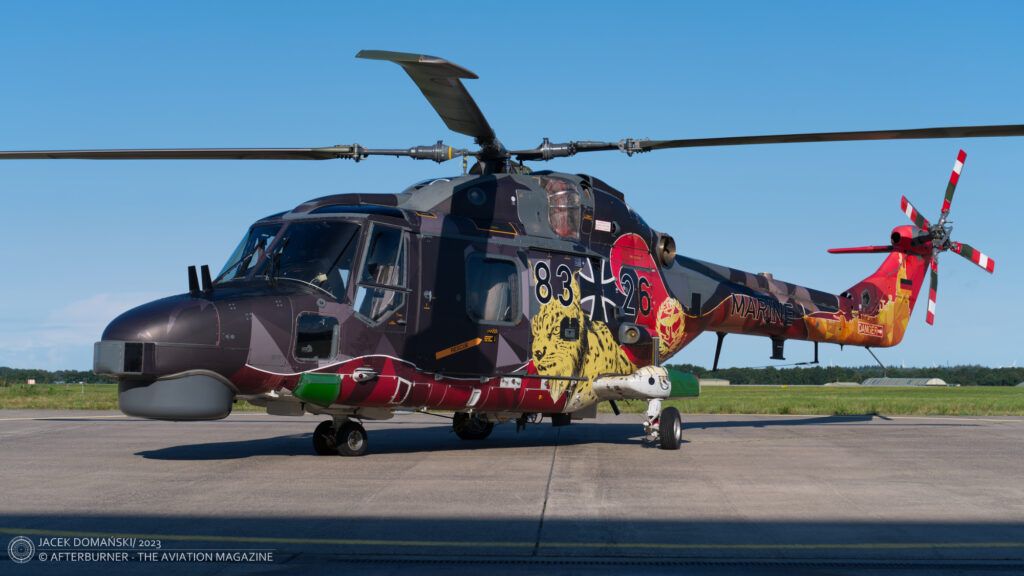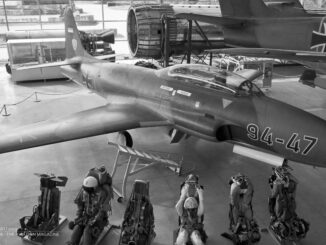 Westland Super Lynx Mk 88A (c/n WA.397, ´83+26´ of the German Naval Aviation / Marineflieger), static display during spotter day at Galileo SAR Meet 2023, Nordholz, August 2023.
Westland Super Lynx Mk 88A (c/n WA.397, ´83+26´ of the German Naval Aviation / Marineflieger), static display during spotter day at Galileo SAR Meet 2023, Nordholz, August 2023.
In the mid-1960s, the Westland company developed a new helicopter, designated WG.13 that had to succeed Scout and Wasp rotorcraft. Initially, the WG.13 was intended for both civil and military sectors and had to be manufactured in cooperation with French company Sud Aviation / Aérospatiale. At the beginning, military variants included naval helicopter for the Royal Navy and armed reconnaissance version for the French Army. However, following the French cancellation of the army variant, only the navy and army variants for British forces were further developed.
The new helicopter, now redesignated Westland Lynx, successfully completed its maiden flight on 21st March 1971. During its evaluation and test flights that followed shortly after, the rotorcraft set several world records in speed over a straight course and at closed circuit of 100 kilometres. What´s more, in 1986, a modified Lynx flown by John Trevor Egginton set a world speed record over a straight 15/25 kilometre course, reaching 400.87 kph. That record is still current and is recognized by the FAI as ´Absolute Record of class E (rotorcraft)´.
In 1977, the first Westland Lynx helicopters, designated AH.1, were delivered to the British Army Air Corps. Their operational service officially commenced in 1979 and included a variety of utility and liaison duties, as well as transport, reconnaissance and medevac tasks. Later, the AH.7 variant was upgraded for anti-armour warfare and could carry four TOW anti-tank guided missiles on external pylons.
The first naval variant, designated HAS.2, entered operational service with the Fleet Air Arm in 1981. The Navy used the Lynx rotorcraft for maritime patrol operations, reconnaissance and utility duties. Later, modified variants known as HAS.3 and HMA.8, were used for anti-submarine warfare and in a role of maritime attack helicopters.
Apart from its service with the British armed forces, the Lynx rotorcraft gained international recognition and appreciation by several other armed forces and finally was acquired by seventeen countries all over the world. Currently, the Lynx still remains operational in eight of them.
Until the 2010s, there were approximately 450 examples of the Lynx produced, in more of forty different variants. Then, the helicopter was succeeded by AgustaWestland AW159 Wildcat.
In 1981, the first Sea Lynx Mk 88 rotorcraft were delivered to Bundesmarine (the German Navy). Initially, Germany ordered nineteen examples of that naval variant but in 1996 the fleet was extended with another seven rotorcraft. This time, they were of new, upgraded version, known as Super Lynx Mk 88A. At the end of the 1990s, seventeen German helicopters from the first delivery were also modernised to the Mk 88A standard.
The German Lynx helicopters were assigned to Marinefliegergeschwader 3 (Naval Air Wing 3) ´Graf Zeppelin´, based at Fliegerhorst Nordholz (Nordholz Naval Airbase) in Lower Saxony. In November of 2012, in consequence of restructuring the German armed forces, the rotorcraft were re-assigned to Marinefliegergeschwader 5.
During their service with the German Naval Aviation, the Lynx helicopters initially operated from frigate-class ships and were primarily used for anti-submarine warfare. However, with the end of the Cold War, their duties were extended and included fight against piracy at sea and operations led by the United Nations (such as EUNAVFOR MED IRINI – UN arms embargo on Libya).
In 2017, the German Navy decided about the Sea Lynx retirement. Currently the rotorcraft are successively being withdrawn from active service to be replaced with NATO Frigate Helicopter NH90 Sea Tiger. The process is expected to be finalized in 2025.
At the end of 2022, one of the German Super Lynx helicopters received a special – and very attractive – livery to celebrate forty years of the operational service with Marineflieger. Last month, that rotorcraft took part in Galileo SAR Meet held at Nordholz, including static display during the special spotter event – when our current Photo of the Week was taken.



